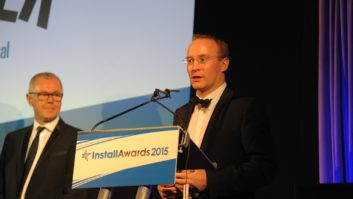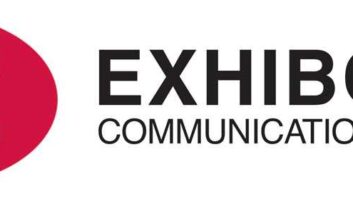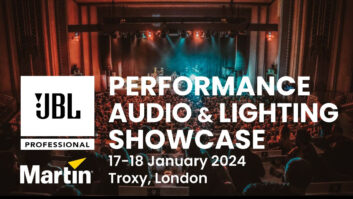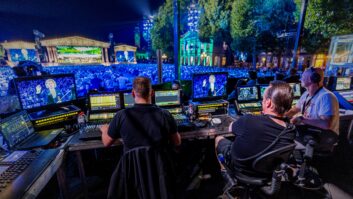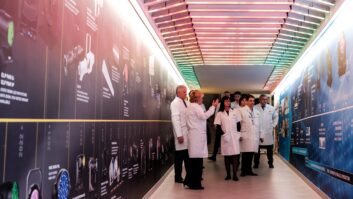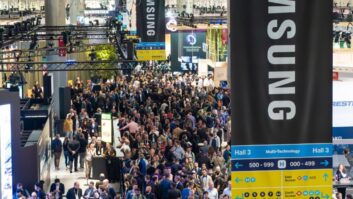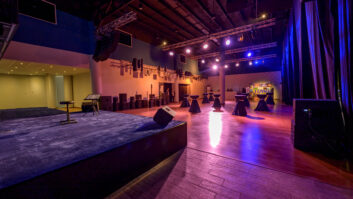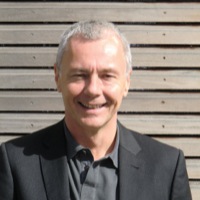
Mike Walker was appointed sales director of Martin Professional’s UK operation in May 2010. Previously he ran his own independent audiovisual consultancy in the entertainment and live events market, and from 1993 to 2007 he was sales director at Creative Technology London, a video equipment rental company serving live event, TV, concert touring and theatre industries.
There was a massive change to Martin’s EMEA operations in 2009. Can you recap on those, and bring us up to date with the UK operation?In 2009, all the country wholly owned subsidiaries of Martin were closed down and an EMEA sales region was created with back office support taking place in Denmark – warehousing, accounting, marketing and so on. All the local territories, including the UK, were just left with a sales and service team.
Since I joined Martin two and a half years ago to run the UK operation we’ve been selling and promoting our range of products through our distribution network; maintaining a dealer network through rental companies; running an entertainment sales operation which is directly to rental companies and distributors; and also the projects division which is directly to architects, installers and end-users of architectural lighting, which is a main area of growth for us. What’s the biggest development that’s happened during your time at Martin?I’d say probably the advent of video – we are the only lighting company that manufactures video products. Why that’s important is that our customers are generally a lighting designer or a lighting business that is called in at the very beginning of an event or a tour. If he’s going to design a show that’s got a logo light on it and then turn up at the first gig six months later with two black holes where the video screens are going to go, and then he meets the video crew and they do their thing – which is how it used to work – you’re not going to get a very coherent design. To be able to place video tools in the hands of the lighting designer who is the first point of contact when the design gets discussed means the lighting designer has some control over the entire look of that show. Does that ethos transfer to fixed installs as well as events?If you are running a corporate HQ and you’ve got a lighting design, the building needs to tell its own story, have its own iconography, its own style and presence. These days that’s usually done with the design of the building but also the way that it’s lit, which is increasingly important. Also media facades, particularly on the continent, are a huge growing market. Corporate HQs will include video as part of the design package. Coming back to the idea of a lighting company with a video product that places it into the hands of a designer – that’s where we’re getting some advantage in the marketplace. For some customers you can take their lighting and their video, and the control elements that they want to have control over and stick it into an iPad app, so they can walk round… and the iPad app can talk to one of our control consoles that is out of the way somewhere. Comparing Martin with big names in the display market, where is the differentiation?If you’re controlling lights and video from one point, then we’ve got a superb argument and a great range of products that fulfils that requirement. If you’re just looking for a video screen then we’re competing with everyone else who’s just got a video screen. And is the architectural market is a growth area for Martin?Yes, very much so, and video’s a very important part of that. We’re very focused on exterior lighting and LED – LED is a big part of our product range right across the board. We’ve been very successful and pioneering in LED so, particularly for exterior colour-changing dynamic LED, we are the market leaders in that area. It’s a niche area, but it’s one where we excel – as well as the media facades.A lot of companies involved in media facades come at it from a DMX perspective. We can do DMX, and we can do video into the screen. If you’re just running a video-based system it’s a lot more elegant solution and a lot less hard work and cabling. Soundcraft has just produced an audio mixing desk with integrated DMX, for venues with one person operating the audio and the lighting. Does that strike you as a good idea?I think you’re going to see consoles that are going to be able to drive everything, whether it’s lighting, video or audio – no question. Convergence in the control domain is a reality already – it’s only going to grow. But I think it’s early days yet to see where the big winners are going to be, and whether a desk that controls lighting and audio on a 50-50 basis, is going to justify investment, or whether it’s a combination of other types of media, we’ll wait and see. But it’s certainly where things are heading, and it’s something we’re deeply involved in at the moment. How does Martin go about selecting the LED emitters in its products?You go to the very best producers of LEDs. When you put a load of LEDs together and they’ve got to reproduce an exact colour to a very high tolerance because there are another thousand of them next door doing exactly the same thing, then those LEDs have got to be of the very highest quality. The best LEDs you can buy are widely regarded to be Nichia – they’re batched into different grades, and within a batch there’s a certain tolerance. That tolerance is acceptable for most applications, but not for video and for lighting. So what we do is we take the highest-quality batches of LEDs we can get, then we spend half a million quid on a camera which looks at them all together with a load of other lights or a load of video screens, and we tweak them individually.
So wherever you buy one of our LED lights, it exactly matches one that you bought six months ago, or you’re going to buy next year; or on our video screens, from panel to panel, from batch to batch, if you put a white field on them, it’s white on this one, it’s white on the next – exactly the same photometrics are coming off each one.It’s a big differentiator from other manufacturers, and particularly from cheaper products that are coming in from overseas. Incidentally, we recently closed down our Chinese operation – every light with a Martin badge is now made in Denmark.
But the reality is that people buy what’s available right now, or where they can get a great deal. If you were to buy on merit alone you’d only ever buy products like ours, but market demands work differently. Are you committed to the top end of the market, or is there any scope in coming down?We are committed to the top end. We saw LED as being a huge growth area, and inevitably all lighting would have an LED variant at some point. As a lighting manufacturer you’ve got to get behind that. We got behind it with a €3 million investment which we split with the University of Aalborg in Denmark as a project to develop sustainable future lighting instruments, out of which came our current range of LED lights. What do you mean by sustainable in that context?Sustainable, from the point of view of the university, means delivering lower power demands, lower lifetime costs and no lamp replacement. It’s generally accepted that LEDs are more environmentally friendly than lamps in different ways, although there’s still a lot of discussion about what and how much. So while we’ve been involved in LED for quite some time, we’ve just brought out one of our most important lamp-based lights ever: the MAC Viper, a 1,000W system, which is going to be an industry workhorse. LED hasn’t got up to the 26,000 lumens output that a lamp can still give you. It will do some day. What do you think is going to happen in the market in terms of the number of players?We had to restructure our business, I guess, because we were so dominant and so big that when a recession hits, the biggest is going to feel it the most. All we’ve done is get ourselves into a very agile and nimble shape, the right size for the market. Whether other companies have to do that, I don’t know. Whether there is any appetite for bigger players to buy up smaller players to give them extra bits of market – I don’t think that happens in a shrinking or a flat market, so until the economy picks up I don’t think you’re really going to see much of that going on. How much business you do in fixed install versus events?In the entertainment market, it’s easy to measure year on year how you’re performing. The installation market for us is certainly growing, but you can do lots of really good little jobs and then a couple of huge ones spike the figures in a way that make it difficult to forecast next year’s business. Generally it’s a market that we’re very interested in, and we’ve got some products that make us stand out from the competition. We don’t have an awful lot of competition with the products that we have, so it’s a nice space to operate in. Your main UK sales office is in Long Lane near London’s Covent Garden, but you also have an office in London SE1, which is about to relocate. What’s the story there?
We are currently sub-letting offices from one of our customers, which was a temporary move from 2009. We’ve found premises very close by which suit our purposes better, so we’re going to move there from 24 September.The London Bridge Quarter, as they’re calling it, is quite a cool and trendy place to be. There’s a lot of media, architectural practices, design businesses in the area and the Shard has gone up. We found that since we moved into SE1, it’s a really easy place to get to and people like visiting us here. We found the ideal offices very close to where we started here, so we’re really happy with it. Are you going to put a media facade up outside?It’s a listed building, so we can’t! One day… Why are media facades more popular in mainland Europe than in the UK? It’s to do with licensing and permissions from local authorities. We’re very anti that in the UK. We had many, many requests for screens on buildings around the Olympics, to go on corporate HQs, to be used for a mixture of reasons. But a lot of the London authorities and the UK authorities see anything with movement on it as being a health and safety risk generally… … for people in cars driving past?And seemingly for pedestrians as well, believe it or not – you don’t want pedestrians crashing into each other in our country, apparently. I think there is also a fear of companies getting an unfair advantage by using moving video, compared to everybody else in the business neighbourhood. It’s a bit arcane – the rest of Europe have just accepted video as being what it is, just another form of communication. It’s just a moving poster board really. Can you quantify how far you are through the LED transition process? More or less than halfway?Nearly halfway, I would say. It’s not been established yet whether there’s a Moore‘s Law of LED output. If that comes into being – everything we have, you could see an LED variant of it within five years. Certainly at the middle to lower end, almost everything is LED now. Not only has it replaced traditional kinds of lighting, it’s also opened up its own applications because of how LED works and how small the lights can be – and you can use an LED light as an effect rather than just something to illuminate a surface or a subject. So the growth in the market is to do with how they LEDs things, as well as cost savings, energy, and lamp replacement costs. www.martin.com
